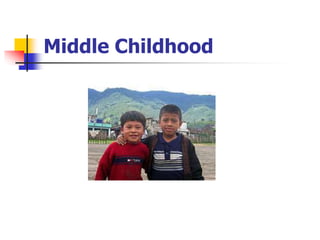
Lifespan Psychology Module 6 Middle Childhood Powerpoint
- 2. Middle Childhood PHYSICAL DEVELOPMENT
- 3. The Healthiest Time Growth slows Gain 5-7 pounds and 2 inches per year Slim down Muscle strength and lung capacity Motor skills improve
- 4. Children and Sports Sports are best when parents stay home College Sports Excesses Seep Into High School
- 5. Childhood Obesity 16-33 percent American children obese Doubled since 1980s Orthopedic, self-esteem problems Pediatric type II diabetes on the rise
- 7. Nutrients for the Day
- 8. Middle Childhood COGNITIVE DEVELOPMENT
- 9. Concrete Operational Stage Classification Identity: 5 is always 5 Reversibility: 2+3=5 and 5-3=2 Reciprocity: 4x6=2x12
- 10. Information Processing Theory Sensory register Working memory Knowledge base Processing speed improves Metacognition: strategize
- 11. Language Development Vocabulary growth at 20 words per day 5th graders know about 40,000 words New understanding of words Grammar more easily learned
- 12. Kohlberg’s Moral Development Preconventional based on reward and punishment Conventional based on what other people think Postconventional based on the welfare of others rather than self
- 13. Developmental Problems Consequences of labeling Self-fulfilling prophecy
- 14. Autism Spectrum Disorders Autism or “selfism” Poor language skills Sensitive to touch, sound, detail Fear change and prefer repetition Lack social awareness or social emotions Asperger’s syndrome
- 15. Learning Disability: “A measured discrepancy between expected learning and actual accomplishment in a particular academic area” (Berger, p. 282)
- 16. Learning Difficulties Specific to academic skills (not retardation) Dyslexia (reading) Dyscalcula (math) Attention deficit disorder (attention) Numerous causes
- 17. Assessment of Intellectual Skills Achievement tests are designed to measure what kids have learned Aptitude tests are designed to measure potential to learn IQ tests are a type of aptitude test
- 18. Gardner’s Domains of Intelligence Logical-mathematical Linguistic Spatial Bodily-kinesthetic Musical Intrapersonal Interpersonal Naturalistic Existential
- 19. Sternberg’s Triarchic Theory of Intelligence Academic (Componential) Creative (experiential) Practical (contextual)
- 20. The World of School Parental involvement Family capital Student perspectives McLaren Student state (298 minutes) Street corner state (66) Home state Sanctity state
- 21. Cultural Influences Hidden curriculum What lessons do children learn that are not part of the stated curriculum?
- 23. The Society of Children A living laboratory for social skills Popular-prosocial children Popular-antisocial children Withdrawn-rejected children Aggressive-rejected children
- 24. Self-Concept Where do the comparisons come from? http://www.bratz.com/ Industry vs. Inferiority
- 25. False Self-Training: Being a child but being held to external, adult standards; having developmental needs denied
- 26. Child Sexual Abuse Sexual act with a child performed by an adult or an older child Disregard for child’s developmental immaturity and inability to understand the sexual behavior (Steele)
- 27. Consequences of Abuse Traumatic Sexualization Betrayal Powerlessness Stigmatization
- 28. Family Tasks Food, clothing, shelter Encourage learning Developing self-esteem Nurturing friendships Providing harmony/stability
- 29. Divorce’s Impact Depends on: Degree of conflict prior to divorce Amount of financial hardship Actions of divorcing couple Adjustment of custodial parent
- 30. Short Term Consequences (First Year) Grieving over loss Reduced standard of living Adjusting to transitions Relief from conflict
- 31. Long Term Negative Consequences Greater anxiety about marriage Unrealistically high expectations for a partner Economic/Occupational impact (tied to financial hardship rather than divorce)
- 32. Positive Consequences: Beyond the Deficit Model Most lead happy, well-adjusted lives Better relationship with custodial parent More communication with mothers More democratic parenting Freedom to escape negative role models Greater emotional independence in sons
- 33. How to Take Care of Yourself During Divorce Take care of your own mental health Allow children to grieve Try to have a conflict-free relationship with ex Comfortable, healthy environment
- 34. Impact of Repartnering Remarriage more difficult than divorce Changes in parenting Disagreement over roles
- 35. Impact of Repartnering Impact on parental involvement Greatest involvement when neither partner has remarried Least involvement when father has remarried and mother has not
- 36. Impact of Repartnering Dating concerns Cohabitation and severed ties
- 37. Stepfamilies/Blended Families As common today as in the 1700-1800s From divorce rather than death “Incomplete institution” (Cherlin) Do children in stepfamilies have more difficulties than those in single-parent families?
- 38. Characteristics of Stepfamilies More complex Born of loss Love not assumed Unclear roles Sexual attractions
- 39. Ten Commandments for Step parenting Neutral territory No preconceived roles Set limits Past loyalties Neutral responses No instant love
- 40. Developmental Stages of Stepfamilies A 7 year process Early stages Fantasy, immersion, and awareness Middle stages Mobilization and action Later stages Contact and resolution
